Math centers are a huge part of my math instruction, and over the years I have had my students complete a lot of different math centers. However, in the past three years as I become more comfortable with math centers, I have begun incorporating at least one higher level math center as part of my normal math center rotations. To see what I typically have in my guided math centers, click here.
Today I want to share with you six of my favorite higher level math centers for fourth and fifth grade students. These math centers are all relatively low to no prep and really get your students thinking about the math they are completing.

1. Target Number Center
Having students create math equations for a target number is a perfect higher level thinking center that you can use from the very beginning of the year. I have a few variations of the target number mat that I like to use. I keep the directions generic enough so I can differentiate for my students or differentiate for the time of the year.
At the beginning of the year when the students are just getting used to the center and becoming proficient with it, I like to just have the target number be a one digit number (which the students roll a dice to create). However as the year progresses, I increase the target number to two digit, three digits, or even four digit numbers for the entire class and for specific students as needed.
I also have a few variations of the different equations the students have to create to equal the target number. Sometimes I do very open-ended equations and allow students to choose, sometimes I am more specific about having a required operation or operations, and sometimes I even require them to use parentheses and a variety of specific operations in their equations.
Click here to download the free math target number mats to use with your students.
2. Error Analysis Tasks
One of my go-to higher-level math centers for my students to complete is error analysis tasks. Last year, I created a set of error analysis task for each standard, with many of the standards having more than one task (You can see these in my TpT store by clicking here). After my students have become proficient in the standard or skill, I like to place an error analysis math task in their center the following week.
I do wait until the students have demonstrated mastery of the skills before requiring them to solve an error analysis task. I have found that they are much more successful with finding errors once they have achieved a level of mastery themselves with the skill. If the students have just been introduced to a skill or concept, they may not have as much success with identifying and correcting errors.
3. Journal Prompts
Having your students write about math is also a great low prep higher-level thinking center to place in your math rotations. I like to use journal questions that require my students to really think in a different way than they normally have about math. I have a set (FREE if you join my email list) of mathematical practices journal prompts that I like to use throughout the year. I like these prompts because they require the students to think creatively and strategically about math and their thinking about math. These journal prompts I use are specially aligned to the Common Core Math Practices standards for grades 3-5.
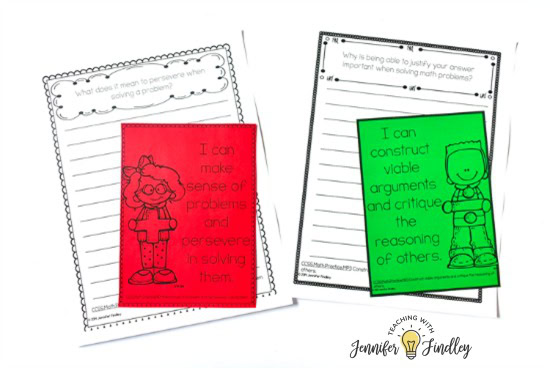
FREE Math Practice Standards Prompts
Join my email list to get the Mathematical Practice Journal Prompts for Grades 3-5 for FREE!
Click here if you would like grade-level specific Math Journal Prompts for 5th Grade.
4. Choice Boards
Choice boards are a perfect way to incorporate both higher level thinking and differentiation into your math centers. You could allow your students to have complete choice over the tasks they complete or you could require 1-2 tasks that are higher level and then allow the students to choose the rest. I prefer choice boards that incorporate both computational mastery and higher level thinking math skills.

- Click here to read a post about how I use choice boards in my classroom and grab some free ones to try out.
- If you are interested in some more choice boards to use all year, click here to see my math choice boards that align directly with common core standards (3rd, 4th, and 5th grade levels available).
5. Create a Word Problem
This is definitely a favorite math center of mine because it is super easy to prep and differentiate. In this center, students choose equations and create word problems to match the equations. It takes another level of thinking for them to be able to create a word problem for an equation, especially word problems that require multiplying and dividing fractions.
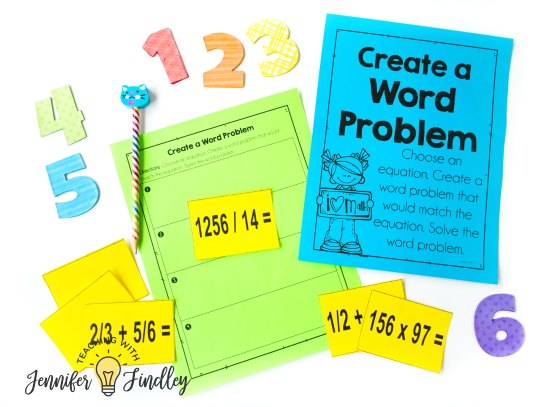
Click here to download the Create a Word Problem math center for free.
6. Constructed Response Tasks
Constructed response math tasks are a huge part of high states testing and a great go-to higher level math center that is very low prep. These tasks are also great for promoting higher level thinking as the students are often required to explain and justify their answers and their thinking.
Because of all this rigor that makes up these tasks, they are perfect for higher level thinking math centers. When I do use these in centers, I typically only require 1-2 tasks in the entire 20 minute center. This gives the students plenty of time to really do the math task justice and answer and explain it fully. Click here to see constructed response math tasks in my TpT store.
Need MORE Math Centers and Activities?
Shop This Post


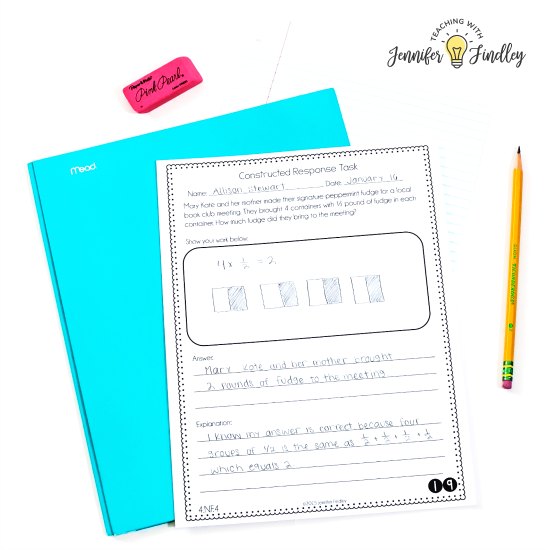
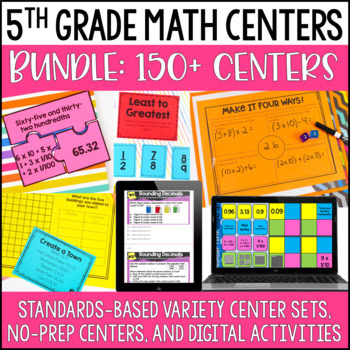
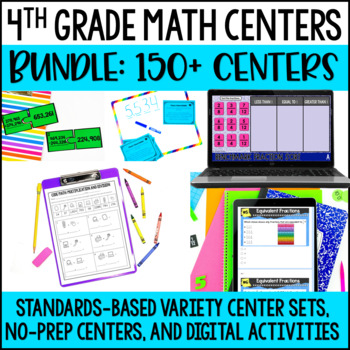
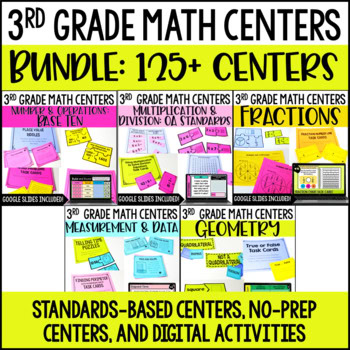






Hi I teach in the UK, we use these types of activities but not in ‘centres’ . Is this a sort of carousel of activities that the children move around? Do you do any whole class teaching as well?
Thanks
Hi Tamsin, yes, centers are similar to a carousel of activities. While the students are completing the activities, I use this time to pull small groups for re-teaching or enrichment. I do centers only about 2 times a week and then whole group the rest of the week. You can read more about it on this post:
https://jenniferfindley.com//2016/01/math-groups-two-ways-i-use-math-groups-in-my-classroom.html
Thanks so much for stopping by!
Hi Jennifer. I’m recently retired from (low tier) university mathematics teaching where we faced a substantial proportion of incoming students who lack mathematical sense. By this I mean that they had very little idea of when they had finished a problem or whether their bottom line answered the questions in any way that made sense. What I’m interested in learning is whether your experience suggests that your center activity which has students invent a story to match an equation seems to directly improve their ability to work from a story to an equation and the interpretation of its solution? Emily
Hi Emily, yes, in my experience it does help them solve word problems. The skill that many of my students lack is a conceptual understanding of what an equation is asking them to do. Requiring them to go from a naked equation to a story problem forces them to think in terms of what the operation is actually representing. Many of my struggling students do struggle with this skill at first but as they grow as math learners, their ability to create story problems grows as well. Thanks for your question!
I’m loving your center ideas. Especially the low prep centers. Thanl you for aharing and giving me some ideas to add to my bag of tricks. My students love error analysis activities. They said they feel like the teacher. Lol! But I will certainly be using the constructed response center, journal prompts, and create a word problem. These are great ideas for upper elementary students! Thanks for sharing, again!
Krystal L. Smith
Love the high level math centers but can’t find the actual cards for the centers like target number center,error analysis tasks,choice boards etc. Is it a download and is it free or is it a purchase.
Thanks so much!
Gail
I found the answer to my question.
Thanks,
Gail
I can’t thank you enough for sharing all your wonderful ideas and resources!
Amazing ideasI will defiantly Be Using these next year . I. have struggled With MY math small groups and How to Challenge students with skills that would be benifical to them, to help build on skills where they struggle .These Are Perfect. Would Love to see more math center ideas .For Example, One for Place value, decimals, fractions,measurements, and multiple step word problems .That includes low to little Prep. I love your blog it is amazing!!!
Jennifer, I love your center ideas but wonder if you take time to grade the student work? I see you only use centers twice a week but that can still generate a good bit of grading. Thanks, Jana
Hi Jana, I don’t grade it all. Check out this post with ideas for assessing math centers: https://jenniferfindley.com//2016/10/assessing-math-centers-2.html
Hi Jennifer,
I teach second grade but am also a math coach. I want to get my second graders to do word problems during my guide math workshop. How do you implement your constructed response questions so that you know your kiddos are successful and understand what they are doing at that station? I have tried many approaches but still struggle with it.
Thanks
Wendy
I have shared your website with the 3rd grade teachers in my building and your games. They really liked your constructed response sheet.
Hi Jennifer,
I must say that since I have discovered your blog I am a little obsessed with all of your ideas and wish to incorporate as much as I can into my class. I know that once I can get all these ideas in place (math centres) my students will shine.
I do have a couple of questions that I am not sure if I missed the answers for.
Firstly, all the recording sheets and numbers of the day activity pages seem like a lot of printing. We have a printing limit that we cannot exceed. Is there a way to diminish the number of printing pages? (ex recording all answers in a copybook)
Secondly, where and how do you store the recording sheets (finished and not finished) Do you have students that never finish their activities?
Thirdly, how often to you change the activities in your centre bins? Do you have many copies of the SAME activities for each student in the group or many SIMILAR activities for each member (ex the numbers are different on each activity sheet) here I’m thinking of your roll and answer station that I love. I just feel that some may finish the sheet before the 15 mins are up and then when they get to that station again the week later, they will have nothing to do.
Sorry for all the questions, it’s just that I am very excited about all of this. I wish you lived closer. I would have you visit my class and help me lol
THANK YOU!!!